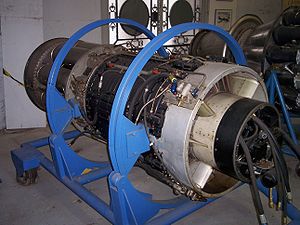|
General Electric J47
The General Electric J47 turbojet (GE company designation TG-190) was developed by General Electric from its earlier J35.[1] It first flew in May 1948. The J47 was the first axial-flow turbojet approved for commercial use in the United States. It was used in many types of aircraft, and more than 30,000 were manufactured before production ceased in 1956. It saw continued service in the US military until 1978. Packard built 3,025 of the engines under license. The J47's greatest advantage, as advertised, was its array of features which were unavailable and unprecedented in any other engine. It was advertised as an 'all-weather engine' due to its anti-icing systems which allowed it to perform at high altitudes and extreme temperatures where other aircraft's performance suffered. Its development began without an explicit need for it, although this design was quickly purchased by the military for its many potential benefits.[2] In 1978, J47s were formally withdrawn from active military duty when the Air National Guard retired the jet-boosted KC-97Js.[3] Despite this, these engines are still extensively utilized in F-86 Sabre jets owned by civilians, making them a common sight at air shows. Design and developmentThe J47 design used experience from the TG-180/J35 engine which was described by Flight magazine in 1948[4] as the most widely used American-conceived turbojet. The turbojet featured a revolutionary anti-icing system where hollow frame struts allowed heated airflow to pass through from the compressor, allowing fighter jets equipped with the engine to function at high altitudes, and in cold conditions such as the top of Mount Washington in New Hampshire's White Mountains, where the engine was first tested. The engine featured an electronically controlled afterburner, a system that dumped additional fuel into the combustor pipe 'behind' the engine, reheating the exhaust and producing significantly more thrust, although with greatly reduced efficiency and high fuel burn rates. The engine production process in the Lockland facility (renamed to the Evendale facility) utilized vertical engine assembly to ensure compressor rotor balance and stability. The technological jump provided by the engine led to it becoming the most produced jet engine in aviation history, and established GE Aviation as a worldwide leader in jet propulsion. Overhaul life for the J47 ranged from 15 hours (in 1948) to a theoretical 1,200 hours (625 achievable in practice) in 1956. For example, the J47-GE-23 was rated to run 225 hours time between overhauls. As installed on the F-86F, it experienced one in-flight shutdown every 33,000 hours in 1955 and 1956.[5] Variants
Applications
Ground-based vehicles that used the engine include:
Nuclear-powered X39In the 1950s, interest in the development of nuclear-powered aircraft led GE to experiment with two nuclear-powered gas turbine designs, one based on the J47, and another new and much larger engine called the X211. The design based on the J47 became the X39 program. This system consisted of two modified J47 engines which, instead of combusting jet fuel, received their heated, compressed air from a heat exchanger that was part of the Heat Transfer Reactor Experiment (HTRE) reactor. The X-39 was successfully operated in conjunction with three different reactors, the HTRE-1, HTRE-2 and HTRE-3.[8] Had the program not been cancelled, these engines would have been used to power the proposed Convair X-6. Specifications (J47-GE-25)Data from [7] General characteristics
Components
Performance
See alsoRelated development Comparable engines Related lists References
External linksWikimedia Commons has media related to General Electric J47. |
||||||||||||||||||||
